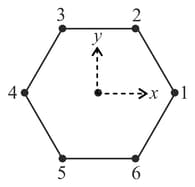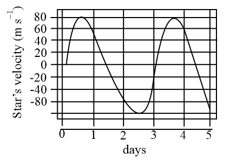At what height from the surface of earth, the value of 'g' is the same as that at a depth of below the surface of the earth? The radius of the earth is .
Important Questions on Gravitation
A very long (length ) cylindrical galaxy is made of uniformly distributed mass and has radius . A star outside the galaxy is orbiting the galaxy in a plane perpendicular to the galaxy and passing through its centre. If the time period of the star is and its distance from the galaxy's axis is , then
Six objects are placed at the vertices of regular hexagon. The geometric centre of the hexagon is at the origin with objects and on the -axis (see figure). The mass of the th object is where is an integer, is constant with dimension of mass and is the angular position of the th vertex measured from the positive -axis in the counter-clockwise sense. If the net gravitational force on body at the centroid vanishes, the value of is

A star mass (equal to the solar mass) with a planet (much smaller than the star) revolves around the star in a circular orbit. The velocity of the star with respect to the centre of mass of star-planet system is shown below:

The radius of the planet's orbit is closest to ()

